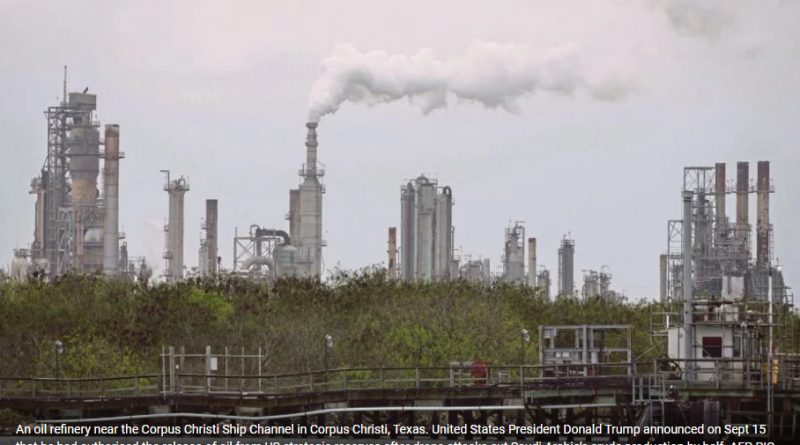Global oil price hike bodes well for Ringgit
KUALA LUMPUR: The sudden surge in oil prices following the attack on Saudi Arabia’s oilfield that has cut the kingdom’s output by half, will be a boon for Malaysia to gain additional oil revenue and increase its trade surplus, while strengthening the local currency, according to market observers.
Brent crude oil traded over US$71 per barrel on Sunday following strikes from 10 unmanned aerial vehicles on Saudi Arabia’s crude-processing facility in Abqaiq on Saturday, erasing about five per cent of the global oil output.
AmBank Group chief economist Dr Anthony Dass said the drone attack would hurt around 5.7 million barrels per day, equivalent to about five per cent of global oil production or 50 per cent of Saudi’s output.
“The immediate impact on oil price could reach as high as US$10 per barrel, and will depend on how fast they are able to restore production,” Dass wrote in a report on Sunday.
However, the spike could be more than US$10, probably US$20, or even higher, should there be retaliation by the Saudis if any neighbouring countries were behind it.
“If this incident has a short-term impact of less than a month, the impact on Malaysia will be neutral.
“It is unlikely for pump prices to move up with the exception of RON 97.
“But should the oil price stay high for a longer period, it should bode well for Malaysia.
“Every US$10 a barrel increase in the price of oil would widen the trade surplus by about 0.4 per cent of gross domestic product (GDP), which would help keep the current account in a comfortable surplus.”
Dass said higher oil prices boded well for the ringgit, as its performance generally correlated to the movement of the commodity.
“The local unit remains bogged down by external risks, but such threats are being cushioned by the strengthening oil prices. The ringgit is expected to be on a stronger footing.”
The government’s subsidies for fuel will also rise in tandem, Dass said, adding that any removal of the subsidies would impact consumers at the pump and increase inflation.
“Currently, retail fuel prices are determined by a float mechanism.
“The impact on retail pump pricing is likely an increase across the board as the government is not expected to absorb the entire rise as it will add pressure on its fuel subsidy.”
Bank Islam Malaysia Bhd chief economist Dr Mohd Afzanizam Abdul Rashid said higher oil prices would definitely be positive for the government’s revenue as the share of oil to total revenue had risen to about 30 per cent this year from about 15 per cent in 2016.
“However, it remains to be seen how sustainable is the trend in light of the supply glut in the crude oil market, as well as the heightening prospect for slower global growth, which would translate into lower demand for crude oil,” he told the New Straits Times.
Afzanizam concurred that the fuel subsidy would be higher if the government decided to maintain the subsidy in its current form.
“Therefore, there are always two sides of the coin when crude oil prices go up.”
Malaysian Industrial Development Finance Bhd Research head Redza Rahman said Malaysia would benefit from the price rise.
“We reckon the knee-jerk reaction that brought the Brent price above US$68 per barrel won’t stay there for long.
“It will likely trend down the lower US$60s over the coming weeks or more, depending on when the facility can resume normal operation.”
Redza said the loss of production capacity was affecting only five per cent of global demand.
“With expectation of lower global economic growth owing to many geopolitical issues such as the trade war and Brexit, we do not see much impact on sustaining the high oil price.”
Meanwhile, Oanda Corporation New York senior market analyst Edward Moya said markets were in for a rude awakening after the most important Saudi oil facility was attacked.
“Oil price is set to surge several percentage points after Saudi Arabia’s production may have been tentatively cut in half.
“Initial assessments are for Saudi Aramco to return almost a third of the crude output that has come offline.”
Moya said the use of drones reminded markets that it would not take a massive military attack to disrupt the world’s biggest crude-processing plant.
“Crude prices are set to soar higher as geopolitical risks were completely off the radar of energy traders.
“West Texas Intermediate crude could see an easy surge above US$60 a barrel, with Brent topping US$70 a barrel.”
However, he believed United States President Donald Trump would not want higher oil prices, and this would likely prompt him to use the Strategic Petroleum Reserve for an emergency sale.
AxiTrader Asia Pacific market strategist Stephen Innes said the market continued to pare defensive positioning, while paring of risk-off strategies unfolded yesterday despite the weekend escalation in the Middle East geopolitical tension.
“While oil prices are still the talk of the town, Saudi Arabia scrambles to repair damage to its energy infrastructure inflicted this weekend.”
Innes said traders would continue to monitor damage reports which would be critical to gauge the interval of this weighty unscheduled market disruption and consequential duration for higher oil prices.
He said historically oil price spikes driven by demand had generally been positive for equities in Asia Pacific.
By contrast, oil price spikes on supply shortages tend to be less embraced.
“However, the most favourable investment sensitivity is in Malaysia since they are a consistent net exporter of oil and gas, running a surplus in trade in these products of 2.7 per cent of GDP in the past year.”
Source: NST



